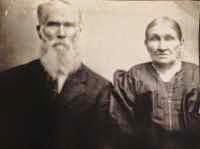George was educated in the Universities of Germany. He spoke German, English and French so perfectly that he could pass as a native in all three. He was also a master of the Latin language. During the Napoleonic wars he was drafted into the services, and was soon taken prisoner to Paris. Here he was treated so kindly that he resolved not to re-enter the army against the French. When the two countries exchanged prisoners, instead of returning home he managed to escape on a vessel bound for America. Having no money to pay his passage, he was sold as an indentured servant for one year to a tanner in Philadelphia. After serving his time he remained several years with this tanner and then drifted into a little Dutch settlement near Harrisburg, Pennsylvania. Here he took up his profession of school teacher, his life’s work. While there he met Juliana Hoke. She was then 17 ½ years old, he was approaching thirty five.
George and Juliana married on April 4, 1816. They made their home in Franklin County, Pennsylvania for 27 years. They became the parents of 12 children, and raised seven of them to maturity. The family, with the exception of their son, John, joined the church when persecution was running high. Juliana, who belonged to the United Bretheren Church, was baptized first in January 1843. George, who was a Lutheran, was baptized two years later. The next year they went to Illinois. They then gathered with the Mormon fugitives in Garden Grove, Iowa in 1846. They remained there a few years in order to prepare to come to Utah.
On May 17, 1851 they left with the saints to cross the plains to Utah in Harry Walton’s company which consisted of 67 wagons and about fifty families. George Gottlob Zimmerman was 70 years old his wife Juliana Hoke was 53. They were accompanied by their widowed daughter Christina, age 33 and her daughter Sarah Julia Stevens, age 2, Julia Ann, 22, Elizabeth 19, Margaret 15, Susan 12, and Rosannah 10. They had one wagon, one yoke of oxen, one yoke of cows, and a horse, so they had to walk most of the way to lighten the load. Because of George's age and never having been around cattle it was impractical for him to drive his wagon to Utah. Their supplies consisted of flour, meal, beans, dried bread, crackers, dried apples, sugar and milk with some butter and bacon and a few dried parsnips. From time to time they had bison meat which they enjoyed very much. All of their experiences with the bison were not as enjoyable however. Oft times they could hear their roaring noise for miles away and could hear them as they would pass the camps on the way to the watering holes at night. More than once the wagon train was cut in two so that herds of bison up to 5000 or more could go rushing through. Stampedes among the cattle and oxen were common things.
The family had good health throughout their journey and also had their share of narrow escapes. A number of deaths occurred on route as well as a few births. While traveling they came across many graves left there by the companies that had preceded them.
They arrived in Salt Lake City on September 25th, 1851. They were a family group of nine who had all their earthly belongings in one wagon. They ranged in age from a mere child of two to a courageous man of seventy. Through swollen rivers of late spring and dusty insect infested plains of summer, up the eastern slopes of the Rockies, down the precipitous ravines of the Wasatch they persevered. Oft times they had only the water of stagnant pools to quench their thirst. They boiled the water and then tried to cool it enough to satisfy their parched throats.
After staying in Salt Lake City a short time they then went on to Lehi. Lehi was settled about a year before and contained about 15 families in the town at that time. They lived in a rented room the first winter. George made and mended all their shoes and the girls did washing and milking. Juliana did lots of knitting. George got plenty of shoemaking to do. He learned the trade from his father who was a master shoe maker and had a number of men working for him back in Germany. There were good crops raised that summer. In the spring George obtained a lot and put a log house on it. Some of the children slept in a covered wagon for two winters.
George was an Elder in the church when he came to Utah, having been ordained December 19, 1847. He was ordained a High Priest in Lehi. George and Juliana went through the Endowment House March 31, 1852. Because of his advanced age, George gave up his profession as a school teacher and settled down in a little adobe house where he cobbled shoes for a livelihood.
In January of 1853 a toll bridge was built over the Jordan River in Lehi. It is now referred to as the "Old Iron Bridge" near 3150 West and 1500 North. George Zimmerman was the first toll collector of that now famous, historic bridge.
During his declining years George was cared for by his daughter Susan. He died in 1866 at the age of eighty five and was buried in Lehi near his wife, who although younger in years, had preceded him to the other side by some two years earlier, at the age of sixty-six.
Ancestral Line: Janeal Kindred Smith... Janice Gregory... Elizabeth Sharp... Margaret Elsie Lamb... Elizabeth Zimmerman... George Gottlob Zimmerman














